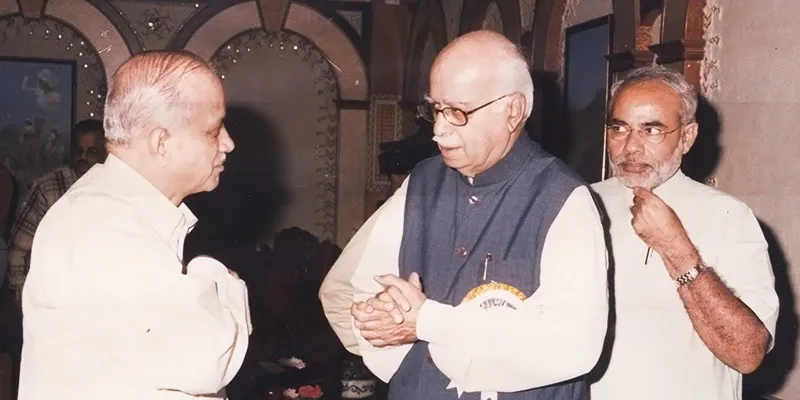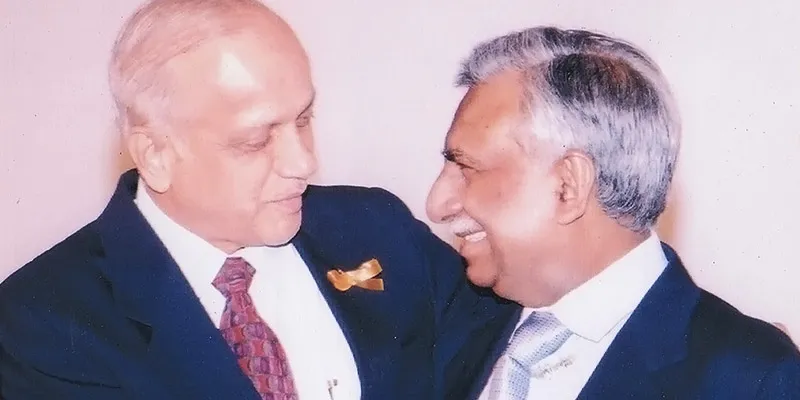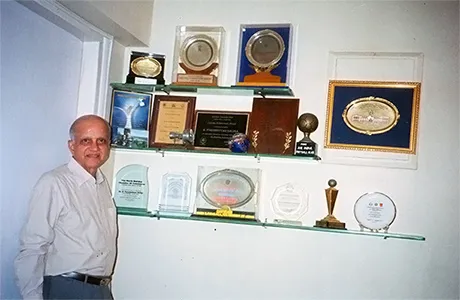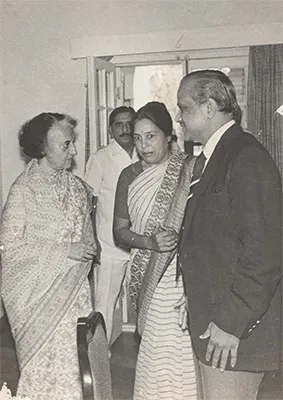The story of B P Baliga, the aviation pioneer, who spent over 50 years at Air India and Jet Airways

If you have ever had a wonderful flying experience on Air India B-747 or Boeing 737 you would have to thank many of the pioneers in the Indian aviation sector. One among them is Bantwal Purushottam Baliga.
B P Baliga was an active member for over five decades in civil aviation related to Aircraft Engineering & Maintenance and Corporate Management at Air India from 1954-1991 and Jet Airways from 1992-2009. Through technological innovations and effective management practices he played a big role in helping the Indian aviation sector grow to the stage it has reached today.
YourStory had the opportunity to interact with him, here is his story.
Beginnings

B P Baliga was born in a humble family in Cannanore, Kerala, on April 4, 1933. Tragedy struck the family of nine children in 1950 as their father suddenly passed away, when most of them were still in their teens. The eldest brother took the responsibility of educating and settling his siblings and took over the family business to set a firm base.
B P Baliga’s first interaction with an airplane was at the age of 11 when he spotted a small aircraft whirling over his home and sprinted to the open maidan to figure out how a plane actually landed.
Baliga completed his Pre-University education at St. Aloysius College, Mangalore, in 1951. He wanted to pursue something interesting and decided to explore engineering. At that time there were only three main avenues -- mechanical, electrical and civil. Aviation was not yet popular or well known. So he considered applying for the merchant navy but was dissuaded by many because of the dangers and perils one faces at sea. A little dejected, he immersed himself in studying for the Bachelor of Arts.
A life changing event took place in July 1951 when his eldest brother, Madhava Baliga, who was now a mentor and father figure, brought to his attention an advertisement in ‘The Hindu’ announcing a course in Aircraft Maintenance Engineering at the Civil Aviation Training Center (CATC) at Allahabad. But by the time he got the news there were only two weeks left to apply for it. So he sent a telegram to the centre stating that he was interested in applying and personally went there to complete the formalities as the regular procedure may have taken too long.
The interview
In the first week of August 1951, Baliga was summoned for an interview with the board. The interview went well and towards the end of it he summoned the courage and boldly asked, “I have come all the way from Mangalore. It has been a three-day journey. If you can give me the slightest indication of my chances I will stay back.” This was in fact a white lie, as he had barely packed enough clothes to last him more than a few days. The board gave him a hint of his chances and requested him to stick around and in two weeks, he got the intimation that he was eligible for the course.
Civil Aviation Training Centre
The training at the CATC would last three years. R. N Khatju, who would go on to become the Director General of Civil Aviation, was the principal of the school at the time. Khatju meticulously taught the fundamentals’ of aircraft maintenance to his pupils reiterating his ‘safety first’ philosophy. This class of graduates would go on to constitute the backbone of the Indian aviation industry in the years to come, with many of them joining different airlines and putting to use their know-how of what was taught to them.
“You are the cream of the country,” Khatju would tell his students, “You must think about the progress in Indian aviation ahead of you. Always aspire to be the best you can; don’t stop at a mediocre level.”
First innings in aviation: Air India
There were vacancies in Air India and Indian Airlines by the time Baliga got his licenses. He gave an interview with Indian Airlines and was selected but the international appeal of Air India beckoned him and he landed in Mumbai to pursue the possibilities there.
On the morning of November 30th, Baliga knocked on the doors of A.C Gazdar, Technical Director of Air India, at the time. “Are you ready for the interview?” Gazdar asked. Baliga was informed that they were starting training in two weeks and that they needed to recruit engineers soon. A little flustered, he relented with the aim of not seeming under confident.
At the end of the interview, Baliga was asked, “Would you like to take the medical?” Baliga was overjoyed and completed the medical examination on the afternoon of the same day. He then bought a two-way Indian Airlines ticket for INR90 and flew to Mangalore the very next day to meet his family in Cannanore, as he had not seen them for three years.
On December 7th 1954, Air India inducted Baliga as a junior trainee. Licenced candidates were trained on the Lockheed constellations. Subsequently, he qualified as an aircraft maintenance engineer on several other aircrafts, including 1049 constellation, Boeing 707 and 747 aircrafts and power plants. Within six months, he passed the required exams and in 1956 he was stationed in Chennai -- in less than two years he had a posting as a Station Engineer. He also got married in 1956 and had his first child.
By the time he had finished his first posting, he was offered a posting abroad at Cairo, since the senior engineer had been sent for training. Then from 1961 to 1964, he was stationed in Moscow, Russia, for another posting as a Maintenance Engineer. Air India became an all Jet airline in 1965 and he returned to Cairo in 1965. The young couple decided to leave their two sons Vinod and Satish behind in Mangalore, not wanting to disrupt their education and took only their one-year-old daughter Asha with them to Cairo.
On his return from Cairo, Baliga was promoted to Assistant Engineering Manager. Thereafter he saw through many other departments in the airline such as Line Maintenance, major maintenance and production planning.
He had just been promoted to the post of Director of Engineering, but the board had not yet confirmed it. Unfortunately due to an incident that occurred on a flight carrying Prime Minister Rajiv Gandhi and Sonia Gandhi, disciplinary action was taken, which held back his promotion. He reconciled to having his promotion declined through no fault of his own, but made clear to the authorities that there was only so much he could bend. A post of ‘Special Duty Officer’ was created for him and he was sent to Toulouse, France, for the technical acceptance of the A310s, which the airline was about to induct into their fleet. He was required to stay there for six months until the completion of the project. This experience would prove invaluable to him later on at Jet Airways.
Baliga contributed to a large amount of foreign exchange saving for Air India. He was confident of the expertise of Indian engineers and insisted that Air India should carry out Section 41, a major modification on four of its Boeing 747s. The aircraft, which had completed 40,000 cycles, replacing 6000 parts, were modified in-house with the help of engineers of the airline and Hindustan Aeronautics Ltd., thus saving valuable dollars.
Also during the Gulf War, Baliga coordinated the operation of Air India flights to Amman for the evacuation of more than a hundred thousand Indian citizens. On his return to Bombay, he was officially reinstated as the Director of Engineering in 1987. He officially retired from Air India in 1991.
Air Lanka, 1991-1992
Air Lanka requested for Baliga’s assistance as he had been a chairman of the South Asian Association for Regional Cooperation (SAARC) Technical Committee. The Sri Lankan carrier had applied for a World Bank loan to acquire an aircraft and needed a project report. They asked Baliga for advice on the A340s and A320s they were planning to order and the commercial and engineering view-points on them.
Baliga agreed to work as a consultant with them for three months. He made the report and submitted to them. Then after Air Lanka acquired the aircraft, they reached out to him again, requesting for help with the implementation. Later on his recommendation, Air Lanka sent their engines to Air India for maintenance too. The report came to be called the ‘Baliga Report’ and the book was followed for subsequent implementations as well.
Second innings at Jet Airways

By March 1992, the idea for Jet Airways had germinated and it was incorporated on April 1st 1992. Naresh Goyal, Founder Chairman of Jet Airways had on-board with him Capt. Williams for flight operations and now needed someone to look after engineering. Rajan Jaitley, MD of Air India, suggested B P Baliga for the post, but Baliga was involved in an accident investigation. So he was not easily reachable and was constantly moving between Mumbai and Kolkata. Baliga was finally able to go and meet the chairman, who gave him an overview of Jet Airways, their proposed plans and how they needed his assistance.
Baliga listened but was in two minds. All his children were abroad and settled and he wondered if he should continue working or take a much needed break as he was approaching 60. But then he decided to join Jet Airways for a short period on a consultancy basis. This short period stretched to almost 17 years as he only retired later in 2009 as the VP, Support Services, at Jet Airways.
A team of enthusiastic individuals would work in a crowded office in Maker Chambers in Mumbai. They suggested to the chairman that a more suitable premise in the suburbs would be a better alternative. At the time Baliga’s wife was away in the US as their daughter was expecting a baby. Since they had two flats in Juhu that were combined, he had them partitioned to make an office in one of them. Once the decision was made, necessary office supplies procured, the core team of Jet Airways shifted their base and started working from their new premises in Baliga’s home. They would send daily fax reports to the Chairman on their progress. When Baliga’s wife returned from the US, she was initially shocked as she was unaware of this arrangement.
The Jet Airways team completed the necessary paperwork and legalities and the Government approved their report in late 1992, and granted them permission to operate. A few more months were spent in procuring the necessary aircrafts and then they started operations on 5th May 1993 with a fleet of 4 B737- 300 aircrafts.
In the years, 1993-94, they had 28 daily flights connecting 28 Indian cities. In 2004, they flew to 42 Indian cities in India and to Colombo, Sri Lanka, Nepal with more than 265 flights a day. They had a market share of 46% at their peak in 2004. Jet Airways currently has the youngest fleet in the world, with over 115 aircrafts which include 12 Airbuses, 59 Boeing 737-800 etc.
When a massive earthquake struck Gujarat in 2001, Jet Airways employees donated a percentage of their salaries to help rehabilitate those affected by contributing to make shift tents and other urgent provisions. L K Advani and India's current Prime Minister, Narendra Modi, greeted Baliga and thanked Jet Airways for the help they had rendered. Baliga and his team also assisted in rebuilding of the Bhuj Airport.
From being a consultant, he went on to be the VP of Engineering and then the VP of Support Services until his retirement. Jet Airways went on to win several national and international awards, including best domestic airline award from H&FS for four years in succession and the prestigious ATW Market Development Award in the year 2000. It was also the first Airline in India to win the TTG Travel Award for best domestic airline in Asia Pacific and FE Business Traveller Award for best domestic airline economy class, business class, airport and inflight services.

In 2006, Baliga was inducted into the International Who’s Who Historical Society (IWWHS) in Washington USA. He was also awarded for Excellence in Aerospace education by the Aeronautical Society of India in 2004.
A Rotarian B P Baliga was also conferred a Special Award for lifetime achievement for Aviation at the 2008 Konkani Sammalen on 5th July at International Convention Centre in Santa Clara, California. The award was presented to him by Padma Shri Prakash Padukone.
Belief, work ethics and idols
As VP at Jet Airways, Baliga had an open door policy -- everyone from cleaners to trainees to maintenance engineers, all were free to interact with him. He still loves interacting with people and making friends, and believes in the policy of ‘give and take’. He feels that if one is doing something for others, then one shouldn’t be shy asking for favours when the need arises. His guiding principle is the 3-D philosophy – Discuss, Decide and Delegate.
JRD Tata was one of Baliga’s idols and source of constant inspiration. Tata always laid emphasis on ‘safety and maintenance’ to provide clean and comfortable rides. Baliga remembers him as a kind and humble person who motivated and urged people around him to do their best.
One particular incident which stands out was when Baliga and his wife Radha had confirmed tickets on SwissAir for Geneva to London, but Tata was not able to get a ticket as the flight was already full. As Baliga was a certified Maintenance Engineer, he spoke to the pilot and was permitted to sit in the cockpit, while Tata occupied his seat. While disembarking from the flight, Tata did not permit Baliga’s wife to carry her hand baggage and insisted on carrying it for her.
His humanity and simplicity touched my heart. He was simplicity personified and showed me how to conduct myself in my future life, recalls Baliga.

Coaching the Air India women’s hockey team and having tea with Indira Gandhi
Though Baliga spent over five decades in aviation, it wasn’t his only passion. He was also a keen sportsman and had represented Air India in tennis, soccer and hockey. He also served terms as the president of Air India Sports Control Board, VP of All India Public Sector Sports Association and President of Khar Gymkhana from 1973- 1977.
He along with the Air India Women’s hockey team were invited for a tea party with former Indian Prime Minister Indira Gandhi. At a certain point, Air India had never had a women’s hockey team.
So we created a women’s hockey team and within two years they went on to win the National Hockey Women’s Championship, says Baliga.
Many years later when ‘Chakde! India’ starring Shah Rukh Khan released, many of Baliga’s friends teased and asked him if the movie was based on his life as there were many parallels in what he had done for the women’s hockey team in coaching them.
Life post retirement and words of advice
Baliga is currently enjoying a life of retirement and was active in sports, till a minor injury forced him to take rest from sports. His sons and daughter, stationed in the US, constantly visit him and he also visits them from time to time. As a trustee, he would actively participate in various activities of the JRD Memorial Trust. He recently moved from Mumbai to Bangalore.

Baliga had also worked on a report titled, ‘How to start an airline’ and listed out the technical as well as management principles that a company needed to follow. Many upcoming airlines all over Asia referred to this manuscript.
On the current scenario of Indian aviation, Baliga feels that though it is not a good time to startup in the aviation sector there is still a tremendous scope for engineers in this field in the long run, as aviation is among the fastest and most convenient modes of transport.
On advice to youngsters, he said, “Nothing but hard work succeeds. One has to take every task as a challenge and results come automatically. As long as your intentions are good and honest, success will come your way.”
On how he was actively working till the age of 78, he says, “One must know their limits. Whenever I thought of retirement, there were people around me to inspire me to keep going till the time I could.”







